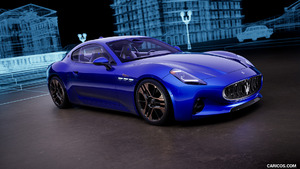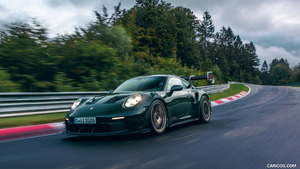Range Rover Sport Td6
Land Rover offers consumers the option of fuel efficient diesel powertrains in two 2016 model year luxury SUVs, the Range Rover and Range Rover Sport. The Range Rover Td6 and Range Rover Sport Td6 SUVs deliver 25 miles per gallon combined, a 32 percent improvement over the supercharged V6 gasoline engine, and reach a high of 29 miles per gallon on the highway.
The two new luxury diesel SUVs debuted at the 2015 North American International Auto Show and went on sale Fall 2015. Land Rover has employed a combination of new and proven innovative technologies to bring North American customers an engine with exceptional refinement, efficiency and performance.
The 3.0-liter Td6 turbocharged V6 diesel engine delivers effortless performance thanks to 254 horsepower and a low-end torque output of 440 lb-ft. Peak torque arrives at 1,750rpm in the Td6 while the gasoline V6 produces its 332 lb-ft at 3,500 rpm. This high torque output at low RPM, makes the diesel Range Rover and Range Rover Sport models particularly well suited to towing heavy loads and off-roading where reaching maximum torque at a lower gear is extremely beneficial. Similarly, the low-end torque of the Td6 allows the vehicles to deliver 0-60 acceleration times comparable to the higher horsepower V6 gasoline models. The Range Rover Sport Td6 and Range Rover Td6 accelerate from 0-60mph in 7.1 and 7.4 seconds3 respectively, compared to 6.9 and 7.1 seconds for gasoline V6 models.
Preliminary fuel economy figures for the Range Rover Sport Td6 and Range Rover Td6 of 22 mpg (city), 29 mpg (highway) and 25 mpg (combined) represent significant gains over traditional gasoline alternatives. The combined figure equates to a 32 percent improvement over the gasoline V6 engine. Total range increases to 658 miles, a gain of 8.0% for the Range Rover Sport and 3.3% for the Range Rover.
These improvements underline a dedication to meeting and exceeding the expectations of luxury SUV consumers. Both the Range Rover and Range Rover Sport have seen significant advancement in fuel efficiency, technology, and design. As part of a complete model redesign for the 2013 and 2014 model years, the Range Rover and Range Rover Sport respectively, have moved to all-aluminum platforms, gained the option of V6 engines and have had significant design changes in an effort to continuously improve Land Rover product offerings. With the addition of Td6, Land Rover is advancing these vehicles even further.
Designed from the ground up, the Td6 provides efficiency and refinement. Its block is constructed using Compacted Graphite Iron (CGI), which has a higher tensile strength than standard grey cast iron, better fatigue strength than aluminum, and added stiffness. Its overall advantages in weight and strength mean the block can be lighter and smaller which make it compact in size. The deep-skirted, cross-bolted design and one-piece structural aluminum oil sump of the Td6 help the engine to absorb combustion noise effectively which improves refinement.
Prior to its introduction in the US, improvements have been made to the Td6 helping to achieve an additional eight percent increase in overall fuel efficiency. These include the addition of a water-cooled turbocharger for maximum performance and durability at high operating temperatures; and new ball bearings, vanes and nozzles to improve efficiency.
A Selective Catalytic Reduction (SCR) system uses Diesel Exhaust Fluid (DEF) to reduce NOx emissions, ensuring the Td6 achieves US LEV 3 status. The DEF is injected into the exhaust and, as the resulting mixture passes through the SCR, NOx is turned into harmless nitrogen gas.
Diesel exhaust fluid is commercially available and owners can top the fluid level up themselves or take it to their nearest Land Rover retailer if the reservoir needs replenishing.
In addition to the cleansing efficiency of the SCR, every aspect of the Td6 engine has been optimized to ensure emissions are as low as possible. This includes the new Low Pressure EGR system which has been critical to the success of Td6 emission ratings and further improves fuel economy.
Unlike traditional High Pressure EGR systems, which recirculate gases directly from the exhaust manifold to inlet manifold at high pressure, the revised design takes gases at low pressure - after the DPF filter in the exhaust pipe - and feeds them back to the turbocharger inlet. From here they pass through an intercooler, resulting in a lower peak combustion temperature.
The higher the peak combustion temperature, the more NOx is produced, so the low pressure EGR system has the effect of reducing the level of NOx produced, by lowering the peak combustion temperature and improving efficiency.
Elsewhere, a two-stage oil pump reduces engine losses while a revised design for the fuel-injectors has been introduced to improve efficiency and reduce hydrocarbon emissions. The injection cycle also employs an innovative two-stage process to eliminate the traditional 'knock' associated with diesel engines.
Attention to detail ensures diesel derivatives deliver traditional Range Rover refinement. Innovative dual-isolation engine mounts, as well as windshields featuring acoustic laminate, help reduce noise levels. Refinement on Range Rover models is further enhanced by the design of the bulkhead between the engine and vehicle interior, which minimizes the transmission of engine noise into the cabin.
The fuel filler neck on diesel Land Rover vehicles is fitted with a misfueling protection device. This device is designed to prevent the narrower gasoline fuel nozzle fitted to gasoline pumps from being inserted into the filler neck on the diesel vehicle, reducing the likelihood of adding the wrong fuel.
Tested and Proven in the USA
Land Rover engineers embarked on US testing schedule to ensure the new diesel engine could handle all US climate and terrain conditions. By the time US sales have begun, the test fleet will have completed one million test miles. The test fleet has targeted the most extreme climates and diverse terrains imaginable across the US. The new Range Rover and Range Rover Sport diesel have navigated from sea level to altitudes of 14,000 feet during the grueling test program. To meet the unique demands of the North American climate, engineers have undertaken testing year round, from the coldest winter days in Minnesota, to summertime in the deserts of the Southwest.

















